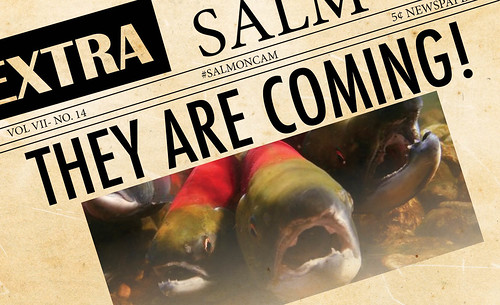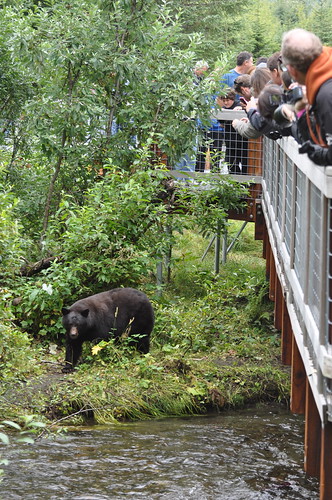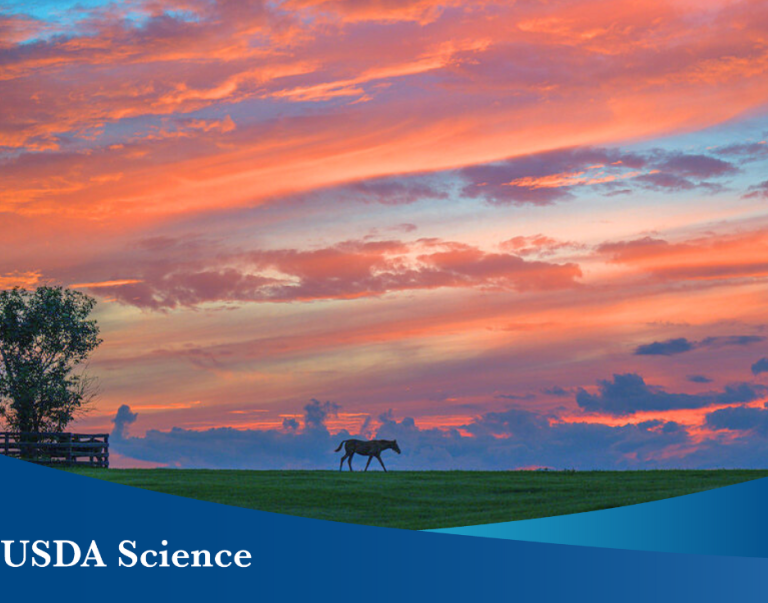
An easy nine miles from the city of Juneau, a portion of a small non-glacial tributary creek nestled among alder, cottonwood and beds of dense, lush moss and understory vegetation is again sharing its ancient story of birth, death and renewal: sockeye and coho salmon are swimming home to spawn.
Yet visitors who want to take in this yearly natural story can view the wonder from the comfort of their own homes via a live online streaming from an underwater camera.
“Steep Creek is one of Alaska’s most productive natural salmon fisheries,” says Pete Schneider, a fisheries biologist for the Tongass National Forest. “This 2.25-mile-long creek takes a precipitous route from Heintzleman Ridge overlooking Mendenhall Lake and the Mendenhall Glacier Visitor Center, but only the lower half mile of the creek is accessible to fish for spawning. Yet despite its short length it contains a wonderful combination of spawning and rearing habitat for salmonids.”
Average stream depths are less than 2 feet and widths range from less than 10 feet in fast-moving sections to over 50 feet in braided gravel locations. Shallow, sediment-filled bodies of water known as kettles are formed by the retreating glacier and provide excellent rearing locations for juvenile fish to feed and seek cover from predators. The deep oxygen-rich water is needed for the salmon to survive frozen spells during the long winters.
“Bears, eagles, otters and mink come to feed here and then toss the nutrient-rich salmon remains along the stream corridor, which in turn feeds and enriches the resulting thick vegetation,” Schneider said. “Based on our temperate rainforest climate, water temperatures rarely rise above 45 degrees as it descends straight off the surrounding mountain.”
So once again, the annual migration of sockeye salmon to Steep Creek will be seen by thousands of viewers via the live video as it has in previous years. Schneider and other forest employees continue to make improvements based on the first salmon cam installed at Steep Creek in 1995 by Eagle Scout Matt Statsny.
Last year, Schneider and his crew upgraded the electrical and camera equipment and ran new coaxial and power cables. They also drove reinforced steel into the substrate of the creek bed for the camera’s stability. This year, they added a new angle for viewer benefit, a second camera to improve viewing opportunities for both on-site and online spectators.
Steep Creek and the Mendenhall Lake support all stages of a salmon’s lifecycle. When the salmon return each year, eggs are laid in redds, depressions in the streambed that the female fish excavate to lay their eggs. After they hatch, they develop from the fry to the smolt stage. After about two years’ growth in fresh water, the smolt make a spring migration downstream to the ocean taking advantage of the snowmelt runoff. They will eventually return to Steep Creek to begin the process all over, sometimes as much as seven years later.
“The fish are best seen on the video during the brightest daylight hours, with the biggest concentration of fish in the stream in late-July,” Schneider said. “The 4- to 7-pound sockeye arrive in mid-July and usually the run winds down by the end of August. The 7- to 10-pound coho (silver) salmon arrive in late September along with Dolly Varden trout. The coho are fewer in number, but their run is stretched out longer. It is common to see ‘fresh’ fish arrive to spawn as late as Thanksgiving and into Christmas, which makes hungry eagles very happy.”
For more details about Steep Creek or the lifecycle of salmon, please read our previous stories about the annual migration and the underwater camera.
This year, a new camera will also scan for returning salmon in Crooked Creek near Valdez, Alaska, on the Chugach National Forest. Visit our blog site for an upcoming blog on this new salmon cam site.



